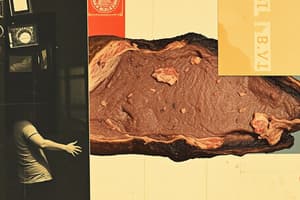Podcast
Questions and Answers
What is the primary benefit of sous vide cooking?
What is the primary benefit of sous vide cooking?
- Decreased preparation time
- Enhancing flavor through smoking
- Controlled temperature for moisture retention (correct)
- Sealing in juices and preventing overcooking
Which method combines heat and mechanical tenderization?
Which method combines heat and mechanical tenderization?
- Thermal-mechanical (correct)
- Wet-aging
- Infrared cooking
- Dry-aging
How does enzyme-assisted aging affect meat?
How does enzyme-assisted aging affect meat?
- Requires high humidity for best results
- Replicates the effects of dry-aging without humidity
- Increases the aging time required
- Transforms tough cuts into tender cuts faster (correct)
What characteristic distinguishes wet-aging from dry-aging?
What characteristic distinguishes wet-aging from dry-aging?
What advantage does combination marinating provide?
What advantage does combination marinating provide?
Which method involves using a meat mallet to improve the tenderness of tough cuts?
Which method involves using a meat mallet to improve the tenderness of tough cuts?
What is the primary purpose of cutting meat against the grain?
What is the primary purpose of cutting meat against the grain?
Which of the following is a type of enzymatic tenderizer found in fruits?
Which of the following is a type of enzymatic tenderizer found in fruits?
What does tumbling achieve in the process of meat tenderization?
What does tumbling achieve in the process of meat tenderization?
Which method can lead to flavor loss when excessively used?
Which method can lead to flavor loss when excessively used?
What are microbial enzymes primarily used for in meat tenderization?
What are microbial enzymes primarily used for in meat tenderization?
Which cooking method is best known for breaking down tough connective tissues?
Which cooking method is best known for breaking down tough connective tissues?
Which of the following is NOT a physical method of tenderizing meat?
Which of the following is NOT a physical method of tenderizing meat?
Flashcards
Sous Vide
Sous Vide
Cooking food in a sealed bag immersed in a precisely controlled water bath. This method ensures even cooking and helps retain moisture.
Infrared Cooking
Infrared Cooking
A method that uses infrared radiation to cook food quickly and evenly, sealing in juices and preventing overcooking.
Combination Marinating
Combination Marinating
A method that combines traditional and modern marinades, using acidic and enzymatic solutions to break down tough meat fibers, along with mechanical techniques like pounding or cutting.
Tenderization-Injection
Tenderization-Injection
Signup and view all the flashcards
Dry-Aging
Dry-Aging
Signup and view all the flashcards
Pounding Meat
Pounding Meat
Signup and view all the flashcards
Cutting Against the Grain
Cutting Against the Grain
Signup and view all the flashcards
Tumbling Meat
Tumbling Meat
Signup and view all the flashcards
Needling Meat
Needling Meat
Signup and view all the flashcards
Acidic Marinades
Acidic Marinades
Signup and view all the flashcards
Enzymatic Tenderizers
Enzymatic Tenderizers
Signup and view all the flashcards
Sodium Tripolyphosphate
Sodium Tripolyphosphate
Signup and view all the flashcards
Alkaline Solutions
Alkaline Solutions
Signup and view all the flashcards
Study Notes
Meat Tenderization Methods
-
Physical/Mechanical Methods: These methods physically alter the meat structure.
- Pounding: Using a mallet to break down muscle fibers, best for tough cuts like steak or pork chops.
- Cutting: Cutting against the grain shortens muscle fibers, improving tenderness. Cubing or slicing also helps.
- Tumbling: Rotating meat to distribute marinades and enzymes, breaking down fibers and infusing flavor.
- Needling: Mechanical tenderizers with needles puncture meat, allowing better marinade penetration and faster cooking.
- Mechanical Tenderization: Specialized machines with blades or needles puncture meat fibers.
-
Chemical Methods: These methods use compounds to break down proteins.
- Acidic Marinades: Vinegar, lemon juice, or wine break down connective tissues and add flavor/moisture.
- Enzymatic Tenderizers: Commercially available enzymes (papaya, pineapple) break down proteins, improving tenderness.
- Sodium Tripolyphosphate: A food additive that retains moisture and tenderizes meat by breaking down proteins, commonly added to processed meats.
- Alkaline Solutions: Baking soda breaks down proteins, though excessive use can reduce flavor and texture.
-
Enzymatic Methods: These methods use natural or microbial enzymes to tenderize.
- Proteolytic Enzymes: Enzymes like papain (papaya), bromelain (pineapple), and ficin (figs) target proteins, break them down, and increase tenderness.
- Natural Enzymes: Many fruits and vegetables have natural enzymes that tenderize meat. Papaya and pineapple are common examples.
- Microbial Enzymes: Commercial tenderizers sometimes use microbial enzymes to tenderize meat without affecting appearance or flavor.
-
Thermal Methods: These methods use heat to break down connective tissues.
- Cooking: Heat breaks down connective tissues, resulting in tender meat when using slow cooking methods like braising and stewing.
- Sous Vide: Precise temperature cooking in a water bath. Extended cooking time helps tenderize tough cuts.
- Infrared Cooking: Faster cooking with infrared radiation. Helps seal in juices and prevents overcooking, producing tender meat.
-
Hybrid Methods: Combining different approaches for enhanced results.
- Combination Marinating: Combining acidic/enzymatic marinades with mechanical methods like pounding or cutting for increased tenderness.
- Tenderization-Injection: Injecting marinade or brine into meat for flavor/moisture, combined with other cooking methods.
- Thermal-Mechanical: Combining heat (e.g., braising) with mechanical methods (e.g., cutting) for improved tenderness.
-
Biological Methods: Methods involving aging to tenderize the meat over time
- Dry-Aging: Aging meat in a controlled environment with low humidity and temperature breaks down muscle fibers and connective tissues, improving tenderness and flavor.
- Wet-Aging: Meat aged in a vacuum-sealed bag, slower aging than dry-aging, minimizing weight loss, and improving consistency.
- Enzyme-Assisted Aging: Injecting enzymes (papain/bromelain) into meat to accelerate the aging process and shorten the tenderness development time.
Studying That Suits You
Use AI to generate personalized quizzes and flashcards to suit your learning preferences.




